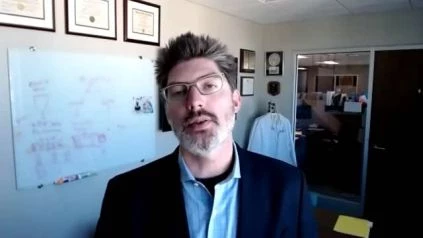Frederick Locke, MD of the Moffitt Cancer Center & Research Institute speaks about the ASH 2020 abstract – 1187 Long-Term Survival and Gradual Recovery of B Cells in Patients with Refractory Large B Cell Lymphoma Treated with Axicabtagene Ciloleucel (Axi-Cel).
Context:
Axi-cel is an autologous T cell anti-CD19 chimeric antigen receptor (CAR) therapy approved for the treatment of patients (pts) with relapsed/refractory large B cell lymphoma (LBCL) with approximately 2 prior systemic therapies. ZUMA-1 is the Phase 1/2 multicenter, single-arm, registrational trial of axi-cel in refractory LBCL pts. Axi-cel demonstrated an objective response, full response (CR), and continuing response rates of 83 percent, 58 percent, and 39 percent, respectively, in a 2-year ZUMA-1 study (median follow-up, 27.1 months; N=101) (Locke et al. Lancet Oncol. 2019). Additional survival follow-up and recovery of normal, polyclonal B cells from continuous responders in ZUMA-1 are presented here.
Methodology:
Eligible pts with refractory large B cell lymphoma (diffuse large B cell lymphoma, main mediastinal B cell lymphoma, transformed follicular lymphoma) were enrolled in leukapheresis and subsequently received low-dose conditioning chemotherapy (fludarabine and cyclophosphamide) accompanied by a target dose of 2 to 106 anti-CD19 CAR T cells/kg T cells/kg (Neelapu et al. NEJM. 2017; NCT02348216). The objective response rate (ORR) was the primary endpoint, and the first response measurement was 4 weeks after infusion. Answer tests were carried out per procedure for up to 24 months or progression of the disease, whichever occurred first. Answer tests per institutional standard of care continued for pts in continuing response beyond Month 24 (SOC). Using polymerase chain reaction, blood levels of CAR T cells were quantified and B cells were characterized using flow cytometry in pts with ongoing responses and evaluable samples.
Outcomes:
A total of 111 pts were enrolled and 101 pts were administered with axi-cel. The median period from axi-cel infusion to both objective response and CR was 1.0 months (range, 1-12 months; Locke et al. Lancet Oncol 2019) between pts that received axi-cel, as previously stated in the ZUMA-1 2-year study. The median processing time was 17 days (range, 14-51; n = 110 as manufacturing was not feasible for 1 pt) when the entire enrolled population (N = 111) was included on an intent-to-treat basis. The median period from enrollment/leukapheresis to objective response and CR was also 1.7 months (range, 0.7-12.9) and 1.9 months (range, 0.7-13.3) among the 111 pts, respectively. Responses were durable, and the median overall survival (OS) was 25.8 months with a minimum of 3 years of follow-up (median, 39.1 months), and the 3-year OS rate was 47 percent. Importantly, no secondary malignancies have been identified associated with axi-cel.
Pts had substantially greater peak CAR T cell expansion in blood 7-14 days after axi-cel infusion in continuous response after 2 years, as previously reported than those with relapse (P = 0.014) or no response (P = 0.0003; Locke et al. Lancet Oncol 2019). For analysis of CAR T cells and evaluation of B cell recovery, blood samples from 22 pts in continuous response (per institutional SOC) at ~ 3 years were available. At 3 years post axi-cel, all assessable pts had detectable B cells in the blood. Notably, 91 percent of pts in continuous response at 3-year follow-up demonstrated recovery of polyclonal B cells assessed on non-malignant CD19+CD20+ B cells by the existence of both kappa and lambda light chains. Reconstitution of the B cell repertoire, consistent with reported evidence from healthy individuals, was indicted by the median kappa-lambda ratio of 1.6 and the relative levels of main B cell subsets, including memory and naive B cell immunophenotypes (Deneys et al. J Immunol Methods 2001; Scott et al. J Clin Pathol 2018). Furthermore, 15/22 (68%) had both minimal levels of detectable gene-marked CAR cells and detectable blood polyclonal B cells. In summary, these results support the hypothesis that the survival of functional CAR T cells is not sufficient for the long-lasting remission of LBCL. Overall survival and translational outcomes will be provided with ~ 4 years of follow-up.
Findings:
Axi-cel in pts with refractory LBCL provided rapid responses and long-term disease control. Most responses occurred through the first evaluation, and both the pace and success of development are confirmed by the limited time elapsed between enrollment and response. In addition, axi-cel-treated pts showed signs of restoration of a normal B cell compartment and clearance of usable CAR T cells, a crucial component of the long-term protection of CD19-directed CAR T cell therapies, with continuous responses at ⇠3 years.

